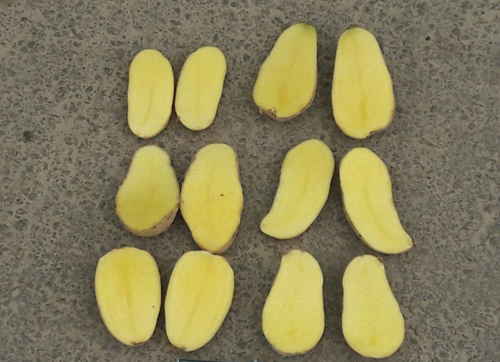Potato variety Granada
Granada is a young medium early potato variety (Solanum tuberosum) for table use. Bred recently, at the end of 2014, by specialists from Solana GmbH & CO KG in Germany. In 2017, it was included in the state register of breeding achievements of the Russian Federation in the Middle Volga region, but in a short period of time it became widespread in many other regions of the country. Suitable for mechanical cleaning, transportation and long-term storage. It is considered one of the most promising varieties in Europe.

The period from germination to maturation is 70-90 days.
Plant of medium height, intermediate type. The main stem is semi-erect, the lateral ones are moderately spreading, abundantly leafy. Medium to large leaf blade, closed or intermediate type, light green in color. The flowers are white, collected in relatively large corollas. The anthocyanin tint of the inner side of the corolla is very weak or completely absent.
The root system of this potato is well developed, from one plant it is possible to collect 10-14 homogeneous tubers weighing 98-175 grams. Rare specimens can weigh up to 250 grams! The tubers are aligned, have an elongated oval shape. The peel is thin, yellow. The pulp is light yellow, does not darken during cutting and heat treatment. The eyes are very small, superficial, and inconspicuous.
The marketable yield of Granada during state tests varies within 132-306 c / ha, 48-144 c / ha more than the results of the Labadia variety, Nevsky... The maximum indicator was recorded in the Republic of Mordovia - 331 c / ha, at the level of the Nevsky standard. According to some sources, the potential yield per hectare of area can reach 600 centners, but there is no official confirmation of such results in Russia. The marketability of tubers is high - 88-94%, keeping quality is very good - 94%, the tendency to germination is low.

The taste of this potato is excellent. The pulp is medium-sized, not watery, retains its pleasant creamy color during heat treatment. In cooking, tubers are versatile, suitable for cooking any kind of dish, but are best suited for frying, including deep-fried, stuffing, baking and dressing soups. They will also be a great addition to salads and vegetable mixes. The starch content in tubers ranges from 15.7-18.7%.
Granada thrives on any type of soil, but shows the best yield on light sandy soils. In general, the variety perfectly adapts to any growing conditions, therefore, its potential distribution area covers many regions of the country. It was bred quite recently, so there is still not enough official data on yields in different climatic latitudes, but on personal plots, potatoes have proven themselves very well in various regions of Russia and Ukraine.
So, this variety is undemanding to the composition of the soil and weather conditions, is drought-resistant, and also unpretentious in care. But in order to obtain the maximum amount of harvest, you still need to know and apply some agrotechnical subtleties.
- Before planting, tubers are selected and calibrated. It is recommended to choose larger specimens, without mechanical damage and signs of disease. Before planting, it is advisable to germinate them for better germination. Treatment with growth stimulants will not be superfluous.
- Seed material can be planted after the ground warms up to + 8-10 ° C and the danger of return frosts has passed, around the beginning of May.
- The planting depth is 10-12 cm for loose soil, for heavy clay about 5 cm.The distance between the holes is 25-30 cm, the row spacing is about 70 cm.
- The Granada variety responds well to feeding. But do not get too carried away with fertilizers, especially nitrogen ones - due to their excess content in the soil, the development of tubers slows down, and the tops begin to grow actively. For poor soils, a double application of top dressing will be enough.
- During the growing season, standard agrotechnical measures should be carried out, such as loosening the soil, hilling, weeding, treatment from diseases and pests. As for watering, as mentioned above, plants are drought-resistant and do not need constant soil moisture. In the southern regions, of course, you need to water the plantings as needed, but in areas with a cool climate, potatoes can do without watering at all throughout the season.
- Do not forget about crop rotation and timely updating of planting material.
The variety is resistant to the causative agent of cancer, golden potato cyst nematode, rhizoctonia, banded wrinkled mosaic and leaf-roll virus. According to some reports, tops and tubers are rarely affected by late blight.
Granada has already earned good reviews from potato growers not only in Europe, but also in Russia. Among the disadvantages, only crop instability in the northern regions and susceptibility to pest damage are noted. The latter is easy to deal with with timely preventive treatments. But the list of advantages is very impressive! These are excellent taste, and excellent yield, excellent presentation of tubers and their resistance to mechanical damage, immunity to a wide range of diseases, suitability for long-term storage and transportation, as well as unpretentious care and undemanding to soil.
Despite the very small age of the variety, you can be sure that it will not let you down!








